#1740s Scotland
Explore tagged Tumblr posts
Text

Red Floral Silk Robe Volante, ca. 1740, Scottish.
National Museums Scotland.
#red#floral#silk#dress#womenswear#extant garments#18th century#robe volante#Scotland#Scottish#1740#1740s#1740s Scotland#1740s britain#British#Britain#national museums scotland#1740s dress#1740s extant garment
132 notes
·
View notes
Text

#meme#created by yours truly#scotland#18th century scotland#anniversary#history#18th century#1740s#1746
2 notes
·
View notes
Photo
The Battle of Culloden was the beginning of the end, for it would lead to laws restricting the freedom of the Scots, particularly the Highlanders. These laws were designed to eradicate Highland culture, and among many other things disarmed the Scots, forbade the use of Scottish Gaelic, and restricted traditional Highland dress, as men and boys were not allowed to wear kilts. Even bagpipes would be banned in Scotland until the 1780s.

Enclosed, a Portrait of His Grace, Prince William Augustus, “the Butcher”, Duke of Cumberland. I am told it is a Fine Likeness.
#reblog#georgiansuggestion#anniversary#meme#history meme#history#1740s#1746#18th century#18th century scotland#scotland
256 notes
·
View notes
Text






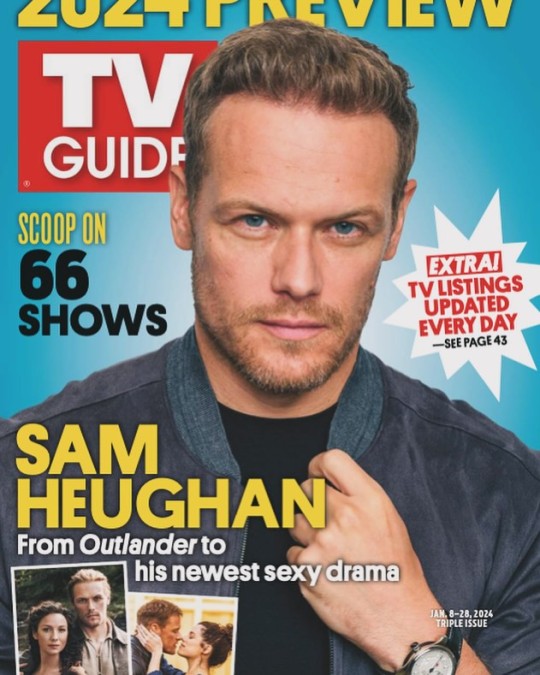


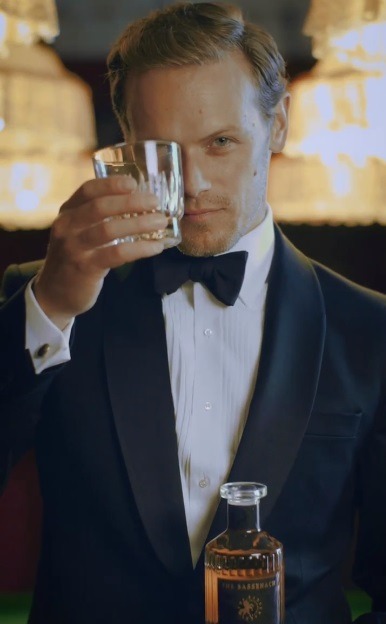

Happy Birthday Sam Roland Heughan, born 30th April 1980 in Balmaclellan, Dumfries and Galloway.
Sam got his name from the Lord of the Rings character Samwise Gamgee. his parents were big fans of the Tolkien books. He attended Kells Primary School in New Galloway before the family moved to Edinburgh when he was 12, he went to James Gillespie’s on the edge of the meadows before finishing his school education at the prestigious Rudolph Steiner School.
After leaving School at 18 Sam worked and travelled before returning to Scotland and enrolling in the Royal Scottish Academy of Music and Drama, graduating in 2003.
Sam built a solid career in theatre in both Scotland and England starring in productions of Plague Over England, Macbeth, The Talented Mr. Ripley, Amphibians, and King John. He has also been featured in notable indie films, Emulsion, and Heart Of Lightness but of course it is one particular role that has catapulted him into worldwide stardom, that of Jamie Fraser in Outlander.
For those who don’t know Outlander it follows the story of Claire Randall, a married combat nurse from 1945 who finds herself hurled back in time to the 1740’s in and around the time when The Jacobites and Bonnie Prince Charlie made the final ill fated attempt to put the Stuarts back on the throne. Sam plays Claire’s “love interest” she is forced to marry. Further series are set in the US in the 1770’s, their remains a strong Scottish presence in the cast, and the show is filmed in studios in Cumbernauld. Sam has won a number of awards for the series.
In the movie To Olivia he played Hollywood star Paul Newman and in the adaptation of the Andy McNab book, SAS: Red Notice, he played SAS soldier Tom Buckingham. Oor birthdat boy also teamed up with fellow Outlander star Graham McTavish Men in Kilts: A Roadtrip with Sam and Graham. The series follows the pair as they explore their homeland delving into the culture and history of Scotland, in a light-hearted way. The second series of the show aired last year, the reviews were mainly positive. The duo are already looking at a third journey, this time to North America but that will likely involve indulging Heughan's thrill-seeking side - much to his friend's dismay
Sam also appeared in the psychological series The Couple Next Door last year, I am yet to catch this, it has average reviews on IMDB of 5.6 out of ten. Born to be Great the story of Alexander The Great's early life has been completed but is yet to recieve a release date.
According to reports Sam celebrated his birthday in Edinburgh at the weekend while also running his My Peak Challenge which included workouts, outdoor activities and a gala night with dinner and dancing. He posted on Instagram describing the event as a 'unique blend of wellness, camaraderie, celebration and more'. The peakers, as they are known has raised millions for charities including Marie Curie.
97 notes
·
View notes
Text
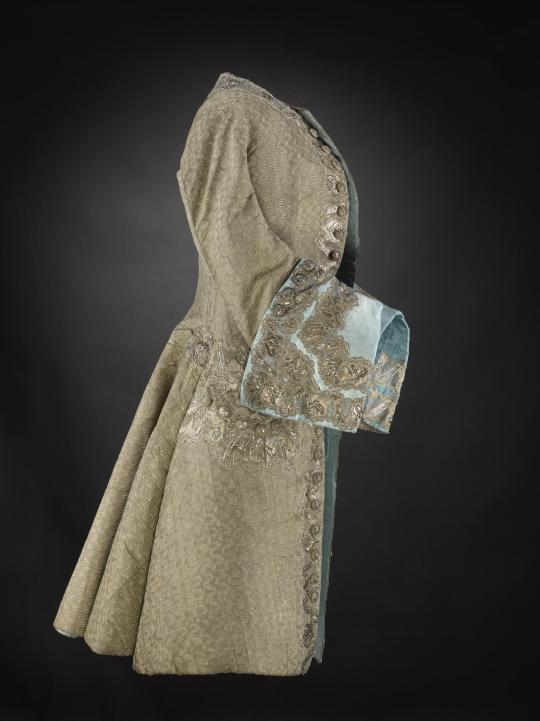
Men's coat of brown figured silk with cuffs and lining in pale blue silk, trimmed with silver lace, circa 1740
From the National Museum of Scotland
70 notes
·
View notes
Text
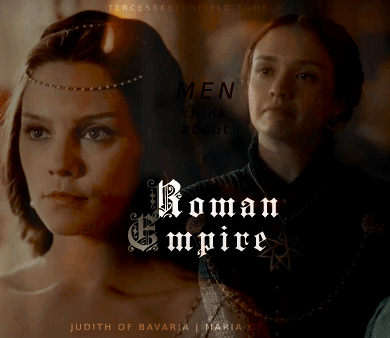
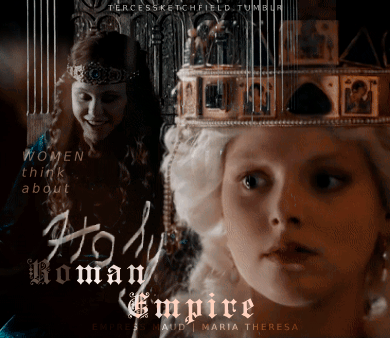
MEN THINK ABOUT ROMAN EMPIRE. WOMEN THINK ABOUT HOLY ROMAN EMPIRE
JUDITH OF BAVARIA (797-843) — Daughter of Count Welf I of Bavaria, Judith was a Carolingian Empress as the second wife of Louis I the Pious. Mother of Gisela and Charles the Bald, she foght for both her own influence at court and for the succession of her son over the claims of his elder half-brothers, the sons of Louis I from his first marriage. Charles became the Emperor in 875, after the death of Louis II, his nephew and a son of his half-brother Lothair / fancast: Annabel Scholey
MARIA OF AUSTRIA (1528-1603) — Daughter of Charles V, Holy Roman Emperor, and Isabella of Portugal. She served as Regent of Spain both jointly with her husband, Maximilian (before their accession to the imperial throne), and in person, for her father, and brother, Philip II. Her children include two Holy Roman Emperors, Rudolf II and Matthias, over whom she held great influence, and queens consorts of Spain, and France / fancast: Olivia Cooke
EMPRESS MAUD (1102-1167) — Daughter of Henry I of England and Matilda of Scotland. Her first marriage to the Holy Roman Emperor, Henry V, gave her the title under which she came down into history, and was a source of great pride to Maud. Rightful heiress of Henry I, she confronted her cousin, King Stephen, in the civil war, known as the Anarchy, fighting ferociously for her rights. She failed in this for herself but won for her son Henry, who became king and established the Plantagenet dynasty in England / cast: Alison Pill in The Pillars of the Earth (2010)
MARIA THERESA (1717-1780) — She succeded her father Charles VI as the ruler of Habsburg monarchy in 1740, and devoutedly defended it against its enemies in the War of Austrian Succession and the Seven Year's War. Wife of the Holy Roman Emperor, Francis I, she was a forceful personality and a competent ruler herself, reigning first in her own right, and later, jointly with her son Empreror Joseph II. Her children include two Holy Romam Emperors (Joseph II and Leopold II), queens consorts of Naples ans Sicily, and France / cast: Marie-Luise Stockinger in Maria Theresia (2017)
#historyedit#judith of bavaria#maria of austria#empress maud#empress matilda#maria theresa#maria theresia#perioddramaedit#history#women in history#perioddramasource#onlyperioddramas#tusereliza#userbennet#usermina#weloveperioddrama#cortegiania#perioddramagif#gifshistorical#my edit#*i have literally zero idea what is this lmao* but i really like it idk
141 notes
·
View notes
Text

The pistol worn by SH is an example of a very scarce model of the British military pattern flintlock pistol/1760/78 Royal Forester's Light Dragoon Flintlock Pistol This pistol is the same pattern shown by SH during filming Outlander season 8 at Eglinton Country Park in Scotland 🏴
The pistol military furniture is all brass, a typical officer's type short eared style skull crusher butt cap terminating with a grotesque mask this type became fashionable in the 1740s. The butt had a metal base (known as a skull crusher butt cap) so the pistol could be used as a club once fired. The lock is the early banana form, typical of the earliest 18th century long pistols.



📸 Robert Wilson

The type of pistol is a flintlock pistol, because British gunmakers took a leading role in the development of the flintlock in the second half of the eighteenth century – popular from 1720-1760, had a barrel standardized at 12 inches that exhibited the butt-caps in the form of grotesque face masks – the best quality being chased and engraved silver, whereas military and civilian models were cast in brass.
#pistol #Britishmilitary #flintlockpistol #brass #buttcaps #RoyalForester'sLightDragoon #Outlander #season8 #EglintonCountryPark #Scotland #gunmakers
Posted 27th October 2024
8 notes
·
View notes
Text
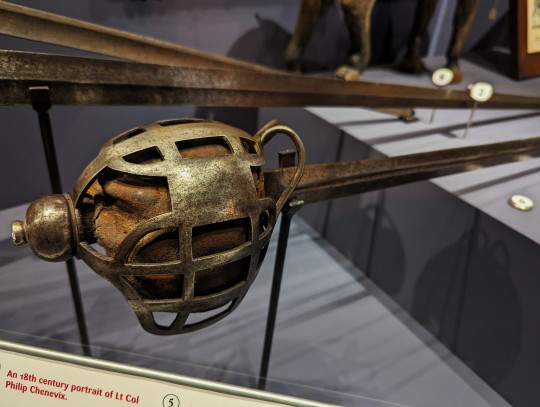
Basket-Hilted Cavalry Sword from the British Empire dated to the Mid-18th Century on display at the Royal Scots Dragoon Guards Museum in Edinburgh Castle, Scotland
Swords of this type were purchased by the colonels of the British cavalry regiments for the use of their men. The styles of hilt varied from regiment to regiment. Basket-hilted swords became popular, not just with Scottish regiments but many cavalry regiments around Europe.
The 2nd Royal North British Dragoons were part of the War of Austrian Succession (1740 - 1748) as part of the coalition forces. They fought at the battle of Dettingen in 1743 where King George II became the last British monarch to fight in a battle. In 1745 the last Jacobite Rising took place and unlike in the last risings the regiment were left in Flanders.
Photographs taken by myself 2023
#sword#british empire#cavalry#scotland#scottish#military history#18th century#georgian#hanoverian#royal scots dragoon guards museum#edinburgh castle#barbucomedie
47 notes
·
View notes
Note
Since you’ve posted extensively about James Barry - I would love to know if you have any idea of how he represented his nationality while in the military.
He was said to have claimed London as his birthplace during his student years and identified as English in his thesis. However, I haven't come across any such details about his later years. Considering he was known to give varying birth years, I wonder if his claims about his origins shifted too.
There's obviously also the letter to his brother John (1808 I think), where he mentioned the honour of dying for one's country and his own desire to join the military. This could be sarcastic given the family's problems, but it might also suggest he was patriotic-ish towards a British identity.
As we know Regency - early Victorian wasn’t a very good time to be proudly Irish among the UK ruling class. He also lived through the Irish Potato Famine, which makes his stance even more intriguing. Did he conceal his Irish Catholic background throughout his life? What about his accent? Moving to England in his teens, he could have adopted a new accent, which wouldn’t be too difficult with determination I guess.
As a side note, apparently his father Jeremiah was eventually deported to Australia, tearing the family further apart. 🥲
This is such a good question! And something I’m really interested in learning more about.
My current theory is that Barry didn’t obviously identify as Irish in public. Ireland and Britain were merged in 1801 to become The United Kingdom of Great Britain and Ireland, though obviously England had been ruling Ireland long before that. Therefore Barry would’ve grown up in Ireland possibly already considering himself British. Historically there hasn’t been such a divide with being both (making that important distinction between being British and being English), much like how many Scottish people today are happy to consider themselves British also. Barry is often described as being Scotch in countenance and having studied in Scotland I wonder if he did let people assume he was Scottish rather than Irish. The accents aren’t too dissimilar to an ignorant ear and that would also allow him to get away with the odd word as Gaeilge in a way identifying himself as english wouldn’t. I know he gave his place of birth as London at some point but there is nothing to say he didn’t tell people his family were Scottish, or even Irish though I doubt it.
The thing about mentioning dying for one’s country, many Irish people died in World War I because they signed up to fight for Britain. Many. Ireland in 1914 was in a similar place to Ireland in 1801 regarding Britain’s rule, just the other way around. A lot of people regarded the war as their chance to fight for their country - yes even if they were proudly Irish they felt this was their fight too. (Not everyone obviously otherwise the Rising wouldn’t’ve happened but a not insignificant number of Irish people did go off to fight for Britain because they felt it was their duty.)
Ah the thing about the Great Famine (1845-1852) is that Barry was far far away at that point. I’m not sure how much he would’ve known about it and most (all) of what he did know would most likely have been from English newspapers, which we know are not necessarily fair on Ireland even today. However Barry was also born within living memory of an earlier famine (1740). James Barry RA was born in 1741, right at the tail end of that famine, and so Mary Anne Barry was probably not far behind him. I think there was 5 children in the family? Not many so they probably weren’t born too far apart. From my quick google to check when James Barry RA was born it also says his father (Dr Barry’s grandfather) was a coasting trader between England and Ireland.
Barry is sometimes claimed to be the child/grandchild of Lord Buchan, a Scottish Earl, and I wonder if his accent played into that. I could be wrong but James Barry RA’s insistence to be extra kind to his fellow Irish makes me think that although he lived most of his adult life in England he didn’t lose anything from home, probably including his accent. Barry MD may possibly have picked up an English accent when he was over there or he may have not. Which brings me back to my previous point of him passing himself off as Scottish. (Side note: while some people can pick up and drop accents at the top of a hat, I was raised in Ireland to parents with English accents and I never got an Irish accent. Maybe this is why I never see Barry as having lost his accent.)
Regarding Barry’s Catholicism - I’ve read very little but considering he spent most of his life abroad I am inclined to think that there would only have been one or maybe two Christian churches in the area that people attended regardless of their specific denomination. In South Africa this would’ve been a Dutch church, most likely the Dutch Reformed Church. Though of course it wouldn’t surprise me if the Church of England commandeered the Dutch Reformed Church buildings and made them C of E. Either way, I doubt Barry was proudly Catholic, not when working for the British Army.
I think I did know Jeremiah got deported but by all accounts it wasn’t much of a loss considering Mary Anne had been ignoring his correspondence, Barry had become Barry and therefore was not corresponding to anyone from home and John was in the military. It’s possible, considering the places James and John went, that they were actually closer to Jeremiah in Australia than they had been to Jeremiah in Cork.
I’m really interested in researching Barry’s Irish nationality, his Catholicism and also his knowledge of the Irish language, which at that point in time was about equally known as English was in Ireland. Especially in towns and cities and a lot of people could understand both even if they couldn’t speak both. It’s an angle that doesn’t often get considered - I presume because Barry moved to London, trained in Edinburgh and worked with the British army in British colonies - but it’s doubtful to be something that can be overlooked easily especially at the time.
I’m not unhappy when I see older pieces describe Barry as British because technically he was, but I feel that regardless of his own feelings towards being Irish or British, it is neglectful to call him British now. Ireland struggles to claim our notable people because Britain likes to get their claws in, whether because they moved to the UK, ignorance, or something else. And the fact that most historical notable people were Anglo-Irish doesn’t help but the fact that James Barry RA is *always* referred to as Irish and makes me determined to refer to Barry MD as Irish at any given opportunity.
At the end of all that - I know very little. Most of what I’ve said there is pure speculation and theorising from what we do know. I don’t know a lot about being Irish in the British army in the 19th century. I don’t know about religion in South Africa at the time. I don’t know about the opinions regarding being born Irish and British. I don’t know how Barry felt about the Great Famine. I don’t know if he was a staunch Catholic or if he…converted to being Anglican. I don’t know if he spoke Irish. I don’t know if he even wanted to be considered Irish. I don’t know and while some of that is things I can learn, a lot of it is not. I enjoy talking about it and I want to learn more.
#also this was near completely unresearched at all because I wrote it on my 40 minute commute to work on the underground#I do have a post about Barry and the Irish lanaguge if you want. it’s somewhere out there or dm me and I’ll track it down and send the link#also. I’m working on a page hosted by neocities about barry and these are all things I really want to discuss and learn more about#so if you’re interested in Barry please do stick around I am thinking about him a lot#my own post#ask#dr james barry
16 notes
·
View notes
Text

White Floral Cotton Dress, 1740-1760, British.
National Museums Scotland.
#womenswear#extant garments#dress#cotton#18th century#1740s#1750s#1740s britain#1750s britain#floral#red#white#national museums scotland#1740s dress#1750s dress#1740s extant garment#1750s extant garment
322 notes
·
View notes
Text
introduction; the fire starter.



aesthetic | powers & abilities | headcanons | relationships | wanted connections
wait, is that prometheus 'theus' ashfield in the emerald lodge again? i heard through the grapevine, that the fire leaning high fae has been in town for 151 years, and currently works as the owner of emerald lodge. some say he can be hedonistic & arrogant, but i thought he was actually charming & generous. ( lee pace / appears 45, actually 284 / he/him )
i. details
full name: prometheus ashfield nickname(s): theus, ... age: appears 45, actually 284 date of birth: 1740 place of birth: the forest covered mountains of the bavarian alps, somewhere between germany and austria residential area: downtown westray | the forest gender: cis male pronouns: he/him sexuality: pansexual & polyamorous martial status: single occupation: owner and accounts manager of emerald lodge
ii. appearance
faceclaim: lee pace hair: warm brunette, wavy, short back and sides, long on top eyes: hazel with green facial hair: stubble to short beard, shave and repeat height: 196cm | 6'5 body type: tall, lean, athletic, strong
iii. personality
moral alignment: chaotic neutral astrology: aries sun . sagittarius moon . leo rising good traits: charming, generous, passionate, spontaneous, energetic, bad traits: hedonistic, arrogant, reckless, stubborn, quick-tempered,
vi. biography
he was born in the spring of 1740 (he doesn't remember the date), in the bavarian alps between what is now germany and austria. he doesn't remember the name he was given at birth, or at least he claims to have forgotten. in truth, he was somewhat of a prince... or so he says. he recalls his childhood, running amongst the trees and bushes, climbing the ridges and rocky outcrops, and swimming in rivers. he remembers playing with other children, dancing with his people at celebrations, and eating fresh food every day.
from a young age, he was mischievous and curious. he did not fear the local humans as much as he should have. he would appear before lost travellers and agree to guide them in exchange for sweets. he became a local legend, a sprite - so long as you gave him what he asked, you would gain safe passage... but if you tried to trick him, you could find yourself lost in the forest, wandering for days.
he doesn't say why he left, only that he was the only one to do so, and there isn't much to go back to.
after he left, he chose a new name - prometheus - and travelled across europe. sometimes he would stay with his own kind, sometimes he would blend in with witches, or humans, learning their cultures and languages. eventually, he got to the age where he started to grow bored. he found a witch who gave him an idea... a memory loss potion, so he could start all over again. it made things interesting... at first. perhaps it was his fae blood, but eventually, his memories returned. and when they did, he would go somewhere new.
he went to italy, spain, france, england, scotland, wales and ireland. he enjoyed meeting the fae of the lands, but he saw the growing influences and spreading civilisations of humanity. he kept finding witches for potions, but the effect of the memory loss took less and less time to fade.
he can't recall if it was a bad potion or too much drink that made him wake up on the boat from scotland to america, but by the time they reached new york in 1820, theus had accepted his fate. he gave the surname ashfield, and that was how he registered as a citizen. he laid low, avoiding the revolutionary war, retreating into the wilderness to be with his own kind while the humans killed each other. afterwards, he toured america and canada, searching for a place to settle.
in 1873, he came to the growing city of westray in the state of washington. old habits die hard, so he continued his life of revelry and pleasure-seeking. he stopped taking the memory potions since they hardly worked anymore. he'd developed too high of a tolerance for them to last longer than a few months.
his bad behaviour eventually caught up with him, and in 1950, he was presented with his first daughter.
he took in every daughter presented to him (who turned out to be his) and raised them with love. shortly after the arrival of his first daughter, he thought he should establish himself a little more... with the riches he'd acquired, he purchased the emerald lodge and has since become its owner and accounts manager. he always had an interest in counting, and what better thing to count than gold?
six more daughters would follow, and despite his recognition of his high fae blood, his dalliance with a human and a witch resulted in offspring, and they resulted in disdain from his fellow high fae.
prometheus didn't give a shit. he loves his daughters fiercely. he would kill for them, and he would die for them. besides... what's the point of being a fae if you don't bring a little chaos?
2 notes
·
View notes
Text

James Boswell, 1740 - 1795. Diarist and biographer of Dr Samuel Johnson
Artist: George Willison (Scottish, 1741 - 1797)
Date: 1765
Medium: Oil on Canvas
Collection: National Galleries Scotland, Edinburg
Portrait of James Boswell
James Boswell, 9th Laird of Auchinleck (29 October 1740 - 19 May 1795), was a Scottish biographer, diarist, and lawyer, born in Edinburgh. He is best known for his biography of the English writer Samuel Johnson, Life of Samuel Johnson, which is commonly said to be the greatest biography written in the English language. A great mass of Boswell's diaries, letters, and private papers were recovered from the 1920s to the 1950s, and their publication by Yale University has transformed his reputation.
#portrait#oil on canvas#george willison#scottish painter#man#seated#landscape#outdoor#elegant#costume#james boswell#biographer#diarist#lawyer#scottish#scottish history#18th century painting#european#scotland
2 notes
·
View notes
Text
10. Outlander, by Diana Gabaldon
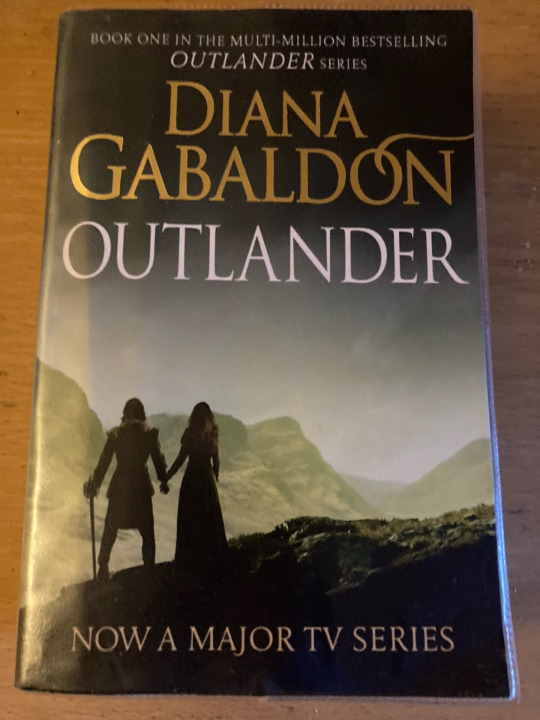
Owned: No, library Page count: 863 My summary: Claire Randall was not expecting much adventure from her honeymoon to Scotland. It's 1946, and the country is still healing from the trauma of the Second World War - Claire and her husband were looking forward to a quiet time away in the country. But when Claire stumbles into a set of standing stones, she finds herself in far over her head. She's fallen back in time, back to 1743, and her husband's great-great-great grandfather has his eyes on her. But Claire has bigger problems. Will she ever get back to her home time? And, given her growing attachment to the young Jacobite she met in the 18th century, will she want to? My rating: 4/5 My commentary:
Well. This is. Not something I expected to find myself reading, I'm not going to lie. I'm gonna straight-up admit that this is due to prejudice on my part - this series is the kind of thing that I associate with middle-aged women, and I don't generally read middle-aged women fiction. But I gave this a shot. It's a romance, which isn't usually my genre, but it's also historical and political and wider than singly the romance story, which is why I wanted to give it a shot. To be clear, there's nothing wrong with romance inherently, I'm just not into it as a genre, so I'm not necessarily gonna enjoy romance if there's nothing else that's in it for me there. Anyway. All of this to say, I enjoyed this a lot more than I thought I was going to, and I'm a little salty about it.
(Warning for talk of rape and sexual assault under the cut.)
As you can tell from the page count, this book's huge, so I'm not gonna talk about every aspect - just a few that jumped out at me. So let's talk about our main characters! Claire and Jamie, a 1940s nurse and a 1740s Jacobite. They're so endearing. Claire is full of personality - she's hotheaded, she's stubborn, she's got a lot of contradictions and flaws, and she's intensely competent. Despite coming from nearly 200 years in the future, she's never really patronising or demeaning towards the people she finds in the past, which is nice - particularly as the narrative also treats them as full people with intelligence as well. Jamie, on the other hand...damn, this is my sorta character. A big strong long-haired history boy with a tragic backstory? Like, I know that Jamie's characterisation is largely there to be appealing to the presumed-straight-woman reader (he's buff, respects Claire, has a tragic backstory and constantly needs healing, etc) but it also falls into my camp of My Favourite Little Woobie. Helps that he's also funny, sweet, and sensitive when need be. He's got depths beyond his character outline, and I like that.
In a historical novel, I'm always looking for how the narrative relates to historicity, and this holds up pretty well. I don't know much about the Jacobite uprisings, but the events presented here are at least plausible to me. Similarly, I don't know much about the intricacies of Scottish politics and Lairds, but as presented here it seemed fine. There's a witch hunt about 20 years too late, but Gabaldon straight-up admits that in the author's note at the back, so like, I can look past that if it's an active Choice. One thing that impressed me was that the characters had historically-plausible attitudes, like misogyny or thinking that smacking kids is okay, and that's dealt with as a part of the narrative. Claire doesn't agree, and after Jamie hits her for disobeying him, she gives him an ultimatum - don't hit her again, or she walks. And he swears to never hit her again. We also see him explain his history with the concept and his point of view, and while I don't agree with him, I can totally see where he's coming from, particularly in the historical setting where he lives.
And it's subtly pointed out that people in the past weren't idiots. While Claire is bringing 20th century nursing techniques to the table, most of the 18th century characters are shown to have reasonably sensible attitudes to medicine. Sure, Jamie carries around a dried mole's paw in his sporran to ward against rheumatism, but also the healers Claire encounters are using herbs to heal in the same way she is, and know how to dress and treat wounds. There's a lot of violence, but there's a lot of complex politics underlying that violence. Things are complicated, and I very much appreciated that.
The final thing I want to talk about is how this book relates to sexuality. First of all, I genuinely enjoyed how horny Claire was! As someone who's sex repulsed, the sex scenes in this book weren't gonna appeal to me in the way that the author intended, which is fine. But it was pretty cool to see Claire actively enjoying sex, both with Frank and with Jamie, and having an active sexuality. And also, there's a lot of emotions underpinning the sex and sexuality - Claire doesn't choose Jamie because he's hot, she's emotionally attached to him too, which is nice. Similarly, I liked that Jamie is a lot less sexually experienced than Claire, particularly as Claire is a more modern woman. He's not exactly a blushing virgin, but he's inexperienced, and that's interesting to see from such a masculine male character. After all, pop culture will tell us that manly men fuck constantly and often, so it's nice that Jamie is a manly man who hasn't really fucked before.
The secondary element to this, however, is how the book uses rape and sexual assault. Claire is under threat of rape a lot, and some of it felt gratuitous - it seems that men are threatened with death and women are threatened with rape, which is gendered in a way I didn't like so much? On the other hand, there's Jamie. At the end of the book, Jamie is jailed by Randall, and Randall rapes him. Like with his earlier virginity, Jamie isn't treated by the narrative as though he's emasculated by this, his trauma is related to just being a rape (and torture) survivor. On the other hand, it's uncomfortable how the explicitly gay or mlm men in this story are characterised as being rapists and assaulters, particularly of younger men. It would have been a lot harder to be a gay man in this time period, but that doesn't mean that every gay man sexually assaults younger men. I don't think the rape in this book is by necessity inherently badly portrayed, but I didn't particularly like the overabundance of it here.
Next up - we're back to the Andes, for yet another trip into the world of survival cannibalism.
12 notes
·
View notes
Text
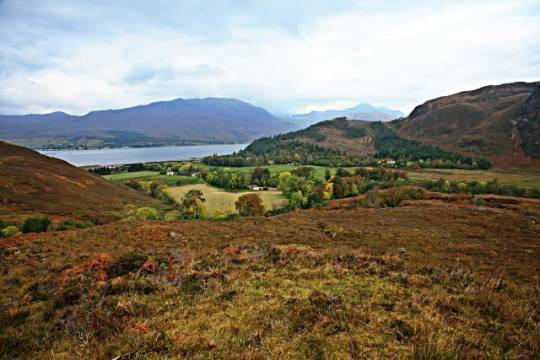


October 2nd 1721 saw the little known Battle of Coille Bhan.
This was more of a skirmish in real terms, but history recall it as a battle, to me the numbers involved make it less so. The way I look at it is that this was also an attempt by the Government of the, still quite new, Union, to impose some sort of rule to the Highland Clans, in this instance it can also go down as leading from an often overlooked Jacobite uprising in 1719, called The “Little Rising“.
The background was that government forces had failed to take the lands of Mackenzie of Seaforth. The taxes being collected by Mackenzie's factor, Donald Murchison were being sent to Mackenzie himself who was living in exile in France for his part in the '15 Jacobite uprising, after which his lands were forfeited to the crown. It was decided that a second attempt should be made to seize Mackenzie of Seaforth's estates.
This time 160 soldiers of Colonel Kirk's regiment left under the command of a Captain McNeil, who unlike their predecessors who had been ambushed in Glen Affric, McNeil took a longer but easier route from Inverness to Dingwall then onto Strath-Garve and Loch Carron.Mackenzie's force were led by Colonel Donald Murchison who had led the ambush at Glen Affric, and I bloody wish my spell check didn't keep trying to make me say Africa instead of Affric!!!
Anyway the Colonel marched his men up a mountain pass called Mam Attadale, a "gallant" relative, named Kenneth Murchison volunteered to attempt an ambush with a small party of 13 at Coille Bhan (White Wood), while the bulk of the party should remain where they were.
Captain McNeil with 18 men of his government force advanced on Kenneth Murchison's position. They received fire in which several of the government troops were wounded and one was killed. McNeil persisted in attacking his enemy and eventually he defeated them and Kenneth Murchison's men withdrew, as they were unable to resist any further, there is no mention of the Jacobite's losses.
The long and short of it is, although Captain McNeil had defeated this advance force, he soon heard of the larger group of Mackenzies waiting at Attadale under the command of Donald Murchison, unwilling to take on these men, who also held the high ground McNeil, himself wounded retreated and high-tailed it back to Inverness.
Kenneth Murchison quickly rejoined Colonel Donald on Mam Attadale, with the cheering intelligence that one salvo of thirteen guns had repelled the hundred and sixty red-coats. No further attempts were made on Mackenzie of Seaforth's lands.
This episode confirmed the view in the south that the Jacobite clans equated with banditry and disorder, but Donald Murchison was also a bold man, reading on, in the History of The Mackenzies he appeared in Edinburgh two years later with £200 in back rents, looking for someone to take it over to France, he was not so stupid as to make himself conspicuous and is said to have been wearing "the garb of a lowlander", he did however spend two weeks in the capital, and although he was a wanted man went unmolested during this time.
Mackenzie of Seaforth, also known as William dubh MacKenzie or Black MacKenzie, like may other Jacobites during earlier uprisings, was later pardoned and returned returned to Scotland in 1726, he died in 1740.
During the '45 uprising, such was the split across The Highlands one of his sons fought on the Hanoverian side in the campaign, whereas a large part of the Clan Mackenzie followed the chief's cousin George Mackenzie, 3rd Earl of Cromartie chose to fight for the Jacobite cause.
The pics shows moorland and Lochcarron, the expanse of land that Clan MacKenzie enjoyed as their own, and their clan crest with the motto Luceo Non Uro (I shine, not burn). MacCoinneach the Gaelic name for the clan means son of the fair bright one.
14 notes
·
View notes
Photo

Jacob More - The Falls of Clyde (Corra Linn) -
oil on canvas, height: 79.4 cm (31.2 in) width: 100.4 cm (39.5 in)
National Galleries Scotland
Jacob More (1740–1793) was a Scottish landscape painter.
52 notes
·
View notes
Text
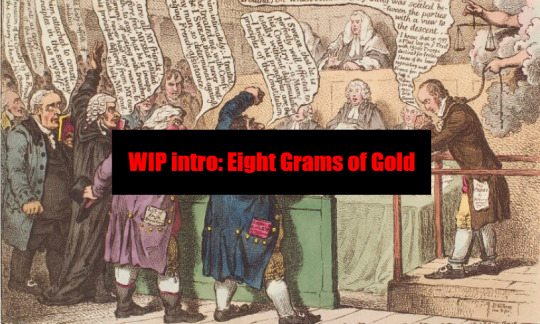
(Detail from James Gillray's political cartoon Evidence to Character: being a Portrait of a Traitor by His Friends and by Himself)
Wip intro: Eight Grams of Gold
Genre: historical fiction, courtroom drama, elements of cosmic horror
Progress: 1st draft
POV: 3rd person limited
Setting: 1795 - 1796 in Ireland + some scenes in England and France
Content warnings: gore / death / abuse / a variety of place-and-time-typical forms of bigotry / cannibalism / etc
Things have not improved for the RRL characters. A stolen shipment of guns, a dead landlord, and now a bizarre personal feud sparked by one man giving another a guinea, which spirals out of control into an esoteric legal battle which threatens to consume everyone and everything. And of course, in the mean time, the spectre of rebellion is looming, and as it is now the year 1796, the clock is slowly counting down.
First, there is Sarah Connolly, a peasant woman, whose son, Frederick, stabs and kills the landlord during the family's eviction. Seeking preservation above all, she sells the body to the innkeeper at the local Essex Arms inn, and washes her hands of the business, content to not ask questions about what innkeeper Lazarus McClure, whose mental stability has been going steadily downhill since the conclusion of the last story, will do with the body and content that she and her family will be safe under their roof for at least another quarter. That is, until it comes out that the Englishman who was meant to inherit his wealth, Charles Nathaniel Maurice Irving-Hamilton, 4th Viscount of Drenning, was recently disinherited in a fit of rage on the part of the man who Frederick stabbed. And the man who will now inherit is a mere bookbinder, a nobody, a tradesman, who infamous aristocratic spymaster Lady Maria Whittaker is incensed to discover will soon be on the same social level as her if he is allowed to acquire the land and the title that would have been Charles' -- who is a bad inheritor, but a suitably titled one.
Whittaker digs up a will. It would seem that the title once came with a lot more land, was severed from it quite by accident in the 1740s, and should, following rather the spirit of the law than the letter, belong to the brother-in-law of the object of Whittaker's very mutual unhinged psychosexual obsession, William Rearden. It isn't too difficult to convince this brother-in-law to contest it. Everyone wants to be a lord, after all. Only, the man who is now a lord refuses to give Whittaker's puppet a thing -- save for a single guinea, handed to him outside church one day as a deliberate mocking gesture. And what's worse, Rearden, who despises his brother-in-law, told him to do it.
AKA: now that I've lured u in with a story about gun-running I will make you listen to me talk about the 18th century Irish legal system for a billion million words ❤️
Ask to be +/- from the taglist!!!
Main Characters
Anthony Franklin -- (he/him) a man of science and lover of liberty from Scotland. A genial family man who loves his friends and chafes at all forms of authority.
Lady Maria Anne Whittaker -- (she/her) a Jacobite-descended Englishwoman whose job it is to get supplies to France, no matter who has to die for it. Loves, apart from herself, her sister.
Eoin O'Donnell -- (he/him) a Defender leader, now on the run from the law. Considered "odd" and "not right" but liked for being very good at terrorism. Has a terminal case of Catholic guilt.
Sarah Connolly -- (she/her) an Irish Catholic peasant woman trapped in an unhappy relationship. Blames herself for a lot but blames other people for more and someday that's going to end very badly for them.
Frederick Craig -- (he/him) Sarah's 11 year old adopted son, recently hired as a drummer boy for the local regiment. Holds a confused ball of resentment within his chest. Has strange dreams.
Annie Craig -- (she/her) Sarah's 12 year old adopted daughter. Considered a touch odd but liked well enough. Determined to find some justice in the situation she finds herself in.
Charles Irving-Hamilton -- (he/him) a worthless Englishman who did not even want to come to Ireland for his uncle's funeral. But he is willing to stay if he can get some entertainment out of ruining this legal battle.
Lady Eliza Durham -- (she/her) a scheming landlady. Has been playing this game a long, long time, long enough to be sure of her ability to best anyone else on this list.
Edward "Lazarus" McClure -- (he/him) a resentment-filled, Derry-born, oak branch-wearing, sham-fighting inn owner. Loves his current fling and Winstanley; hates his father and the law.
Francis "Frank" Borden, Gerald O'Neill -- the new inheritor and Rearden's brother-in-law, respectively.
6 notes
·
View notes